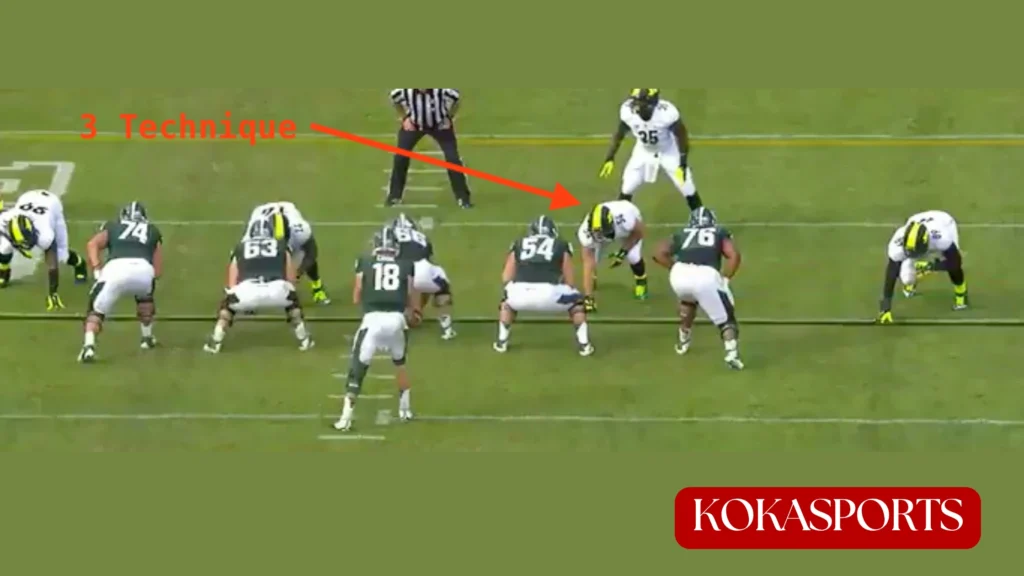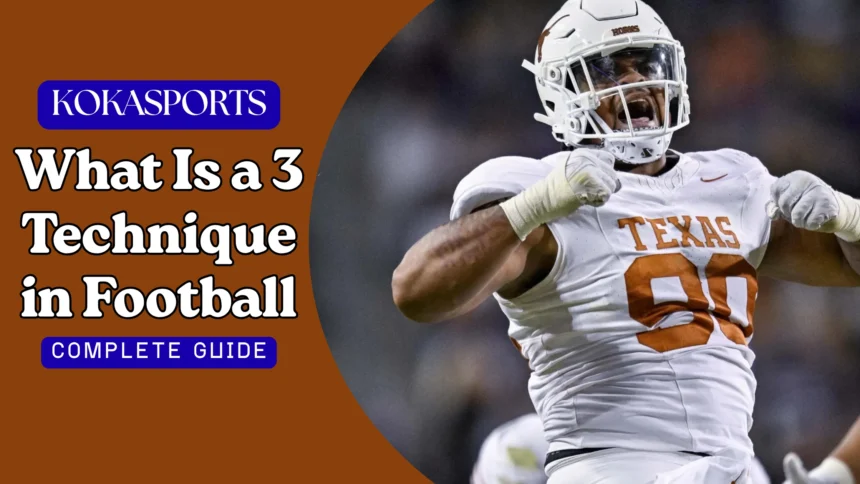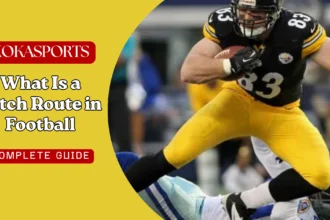When you watch American football, the battle at the line of scrimmage might seem like organized chaos. However, every defensive player has a specific job, and their alignment is carefully planned. One of the most important positions on the defensive side of the ball is the 3-technique. If you’re wondering what is a 3 technique in football, this position has produced some of the most dominant NFL players in history and remains crucial in modern football strategy.
What Is a 3 Technique in Football?

A 3-technique refers to a defensive tackle who lines up on the outside shoulder of the offensive guard. The term “3-technique” comes from a numbering system that coaches use to identify where defensive linemen position themselves along the line of scrimmage. In this system, each gap and alignment spot gets a number, making it easier for coaches to communicate with their players.
The 3-technique position is typically played by a quick, aggressive tackle who can penetrate into the backfield and disrupt plays. Unlike a nose tackle who sits directly over the center, the 3-tech aligns in a spot that allows them to attack the gap between the guard and tackle. This positioning gives them a clear path to create havoc in the offensive line.
What makes this position special is its dual responsibility. A 3-technique tackle must stop the run while also providing interior pass rush. This balance requires a unique skill set that combines power, quickness, and technical mastery. The 3 technique player becomes a disruptive force who can collapse the pocket on passing plays and blow up run plays before they develop.
Read More: Shotgun Formation: A Game-Changing Setup in American Football
Defensive Line Techniques and the Numbering System
To fully grasp what a 3-technique means, you need to know about defensive line techniques and how the numbering system works. Coaches use numbers 0 through 9 to identify where a defender should align before the snap. This system is part of football 101 for anyone studying defensive techniques.
Here’s how the basic numbering breaks down:
- 0-technique: Head-up on the center
- 1-technique: Inside shoulder of the guard (the 1 tech is usually a run-stuffing nose guard)
- 2i-technique: Inside shade on the guard
- 3-technique: Outside shoulder of the offensive guard
- 4i-technique: Inside shade on the tackle
- 5-technique: Outside shoulder of the offensive tackle
- 6-technique: Head-up on the tight end
- 7-technique: Inside shoulder of the tight end
- 8 technique: Outside shoulder of the tight end
- 9-technique: Widest alignment, typically a defensive end
The terms “shade” and “head-up” describe exactly where the defensive lineman positions his body. A shade alignment means lining up on a blocker’s shoulder, while head-up means directly across from them. These small adjustments in positioning can dramatically change how a play develops.
Odd number techniques (1, 3, 5, 7, 9) typically indicate alignments on shoulders, while even number techniques (0, 2, 4, 6, 8) usually mean head-up positions. This numbering system allows a coach to quickly call out an entire defensive front by just saying numbers.
The Role and Responsibilities of the 3 Technique Defensive Tackle

The 3-technique tackle has one of the most demanding jobs on defense. This defensive tackle typically controls the B-gap, which is the space between the guard and tackle on the offensive line. Their primary mission is to penetrate this gap and create problems in the backfield.
In the run game, the 3 technique player must recognize blocking schemes instantly. They need to fight off blocks from the guard, avoid the double team from the guard and tackle, and still make plays. The best 3-tech defenders use leverage and hand placement to defeat these blocks and disrupt running lanes.
During passing situations, the 3-technique becomes a critical pass rusher. They attack from the interior, which is often the quickest path to the quarterback. Interior pressure from a 3-tech is more disruptive than edge pressure because quarterbacks can’t step up in the pocket. This is why defensive prototypes like Aaron Donald are so valuable—they can control the line and destroy the passing game from the inside.
The 3-technique position requires gap integrity, meaning the player must maintain their assigned gap even when tempted to chase the ball. A 3-tech who loses gap discipline creates running lanes for the offense. Great coaches emphasize staying in your gap and trusting your linebackers to make plays when you do your job correctly.
3-Technique vs 1-Technique: Key Differences
Many fans confuse the 1 technique with the 3-technique, but these positions require different skills and body types. The 1-tech (also called a nose guard or nose tackle) lines up on the inside shoulder of the guard or directly over the center and the guard. Their job is to clog up the middle and keep the linebackers clean by occupying multiple blockers.
Here’s a comparison table showing the differences:
| Aspect | 1-Technique | 3-Technique |
|---|---|---|
| Alignment | Inside shoulder of guard | Outside shoulder of guard |
| Gap Responsibility | A-gap (between center and the guard) | B-gap (between guard and tackle) |
| Primary Role | Stop the run, occupy blockers | Penetrate, disrupt, pass rush |
| Ideal Size | 320-350 pounds | 290-310 pounds |
| Key Traits | Strength, size, anchor | Quickness, explosiveness, agility |
| Famous Examples | Vince Wilfork, Haloti Ngata | Aaron Donald, Warren Sapp |
The 1 tech is typically larger and stronger, built to absorb double teams and control the guard and the center. Think of players like Vince Wilfork, who could anchor against two defensive tackles worth of blockers. The 1-tech prioritizes holding ground over penetration.
In contrast, the 3-technique is usually quicker and more athletic. They use speed and technique to shoot gaps on either side and create penetration. While a 1-tech might weigh 340 pounds, a successful 3-tech often weighs 295-305 pounds with exceptional explosion and agility.
How Different Defensive Fronts Use the 3-Technique

The defensive front determines how many defensive linemen take the field and where they align. The 3-technique appears in various formations, but its usage changes based on the style of defense.
In a 4-3 defense (four down linemen, three linebackers), the 3-tech is essential. This base defense typically features two defensive tackles, with at least one playing as a 3-tech. The 4–3 defense allows the 3-technique tackle to attack aggressively because the linebacker behind them can clean up if they’re blocked.
The 3–4 defense (three down linemen, four linebackers) uses the 3-technique differently. In this front, you might see one gap responsibility for the 3-tech, or they might play a two-gap technique depending on the defensive scheme. The 3–4 defense often asks defensive linemen to occupy blockers so linebackers can make plays.
Even older schemes like the 5–2 defense have spots for a 3-tech concept. The defensive coordinator might adjust alignments based on down and distance, offensive formation, or game situation. On the goal line, a defensive tackle lining up as a 3-tech might shift to a different technique to better defend against power running plays.
Coaches also design stunts and twists involving the 3-technique. A common stunt sends the 3-tech crashing inside while a linebacker or defensive end loops around them. These games confuse offensive linemen and create free rushers.
Traits and Skills of an Elite 3-Technique
Not every defensive lineman can excel as a 3-tech. This position demands specific physical and mental traits that separate good players from great ones.
Physical Requirements:
- Explosive first step and quickness off the snap
- Strong hands for shedding blocks and controlling the line of scrimmage
- Low pad level to gain leverage
- Lateral agility to pursue plays
- Core strength to anchor against double teams
Mental Skills:
- Quick recognition of blocking schemes
- Gap discipline and responsibility
- Film study habits to anticipate plays
- High football IQ and awareness
Technical Mastery:
- Hand placement and punch timing
- Footwork to maintain balance
- Various pass rush moves (swim, rip, bull rush)
- Ability to redirect and pursue
The best 3-technique players combine these elements. They study film to recognize the offensive lineman’s stance and predict snap counts. They use quickness to gain initial advantage, then win with power or technique. Elite 3-tech defenders can defeat single blocks consistently and occasionally beat double teams through sheer effort and technique.
Famous 3-Technique Tackles in NFL History
The NFL has showcased many legendary 3-tech players who revolutionized the position. Warren Sapp dominated in the late 1990s and early 2000s, combining size with surprising speed. He helped Tampa Bay win a Super Bowl and changed how teams valued interior pass rushers.
John Randle was undersized by defensive tackle standards but used relentless effort and technique to dominate. His motor never stopped, and he pursued every play along the line of scrimmage with intensity that inspired teammates.
Geno Atkins terrorized NFL offensive lines for years with the Cincinnati Bengals. His low center of gravity and powerful hands made him nearly impossible to handle one-on-one. Atkins proved that a 3-tech at 6’1″ could still dominate much larger opponents.
Aaron Donald might be the greatest 3-technique ever. His combination of strength, speed, and technique is unprecedented. Donald wins with power, speed, or finesse depending on the situation. He’s forced teams to completely redesign their offensive line protection schemes just to account for him. Donald’s success has made the 3-technique position one of the most valued in modern football.
The 3-Technique in Modern Football
Today’s game places even greater emphasis on the 3-tech position. As offenses spread the field and pass more frequently, interior pressure becomes critical. A dominant 3-technique tackle collapses the pocket faster than edge rushers, giving quarterbacks nowhere to escape.
Modern NFL defenses use their 3-tech in creative ways. Four defensive linemen might all shift and stunt before the snap, with the 3-technique as the key to these movements. Teams also substitute their 3-tech based on situation—using a bigger body on early downs and a quicker pass rusher on third down.
Offensive coordinators counter with various tactics. They slide protection toward the 3-tech, use tight end chips, or run away from their weak side where a dominant 3-tech sits. Quick passing games neutralize 3-tech pass rushers by getting the ball out before they can penetrate.
College programs now specifically recruit and develop 3-technique players. They know that NFL teams covet this position, so they train defensive tackles in the skills needed to excel as a 3-tech. Position-specific drills focus on the explosion, hand fighting, and gap integrity that the position demands.
How to Identify a 3-Technique During a Game
When watching gridiron football on TV or from the stands, you can spot the 3-technique by their pre-snap alignment. Look at the defensive tackle positioned on the shoulder of the offensive guard (not the center and the guard). They’ll typically have their inside hand on the ground in a three-point stance.
Watch their stance carefully. A 3-tech often lines up with weight forward, ready to explode into the gap. Their eyes focus on the offensive lineman in front of them, watching for movement. When the ball snaps, the 3-technique should fire immediately into the B-gap, attacking the guard and tackle.
During run defense, watch how the 3-tech fights to stay in their gap. They shouldn’t run themselves out of position chasing the ball. In pass rush, notice how they use different moves—sometimes power, sometimes finesse—to beat their blocker and pressure the quarterback.
Why the 3-Technique Matters
The 3-technique represents the perfect blend of power, speed, and technique in defensive line play. This position can single-handedly disrupt an offense’s game plan, controlling the line of scrimmage and creating opportunities for teammates. Whether it’s run defense or pass rush, the 3-tech provides versatility that every defensive scheme needs.
For fans learning football 101, the 3-technique is essential knowledge. For players aspiring to play defensive tackle, mastering this position opens doors to higher levels of competition. And for coaches, developing a dominant 3-tech can transform an entire defense.
The 3-technique tackle remains a cornerstone of modern defensive football, proving that controlling the line starts with proper alignment and exceptional technique.
FAQs
What is 4 technique football?
A defensive lineman aligned head-up on the offensive tackle, controlling the C-gap.
What is technique in football?
A numbering system (0-9) that identifies where defensive linemen align along the line of scrimmage.
What is a 5 technique in football?
A defensive lineman aligned on the outside shoulder of the offensive tackle, typically setting the edge.
What does 2 technique mean in football?
A defensive tackle aligned head-up on the offensive guard, controlling the A-gap.




